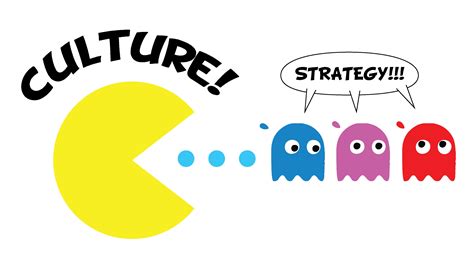
A successful business strategy always involves mobilizing people in pursuit of an organizational objective. Without careful attention to aligning people, this strategy is simply a plan on a piece of paper. So what happens when a new strategy clashes with an old culture?
CULTURE EATS STRATEGY FOR LUNCH!
This adage always reminds us that implementing a business strategy is very different from formulating a business strategy. Formulation often occurs at the top of organizations. But implementation only works when your people align across all levels of an organization—and across all geographies & functions. If you want to implement a new strategy you have to see if your culture can itself become new to embrace it.
A client of mine, who was hired to become a new CEO in an organization where business had not been as successful as the Board of Directors desired, needed new strategies and new ideas in order to turn around the floundering company. Maintaining the old status quo was not going to work. Real significant changes needed to be formulated and implemented successfully as quickly as possible.
The organization had a lot of long term employees. It was a privately held company that was 88 years old. A lot of the success in the organization was due to some long-held practices, policies & beliefs. However, times changed. The organization had been impacted significantly by the changes in their customers buying patterns, needs and interests. The old, outdated, patterns of business needed updated and revitalized.
In working with this client, I helped them to begin changing the culture at the beginning of the strategic planning process. Rather than formulating the strategy without including employees at all levels, and then asking them to implement the strategy after planning was completed, we brought them in to assist in strategy formulation.
This planning process led to the creation of a Culture Committee that was organized and led by employees at all levels representing all functions throughout the organization. The mission was to evaluate the current culture and then decide how to change it to align with the new strategy and business plan.
The decision to include the employees at all levels in the formulation of the strategy along with the initiation of an employee led culture committee enabled this organization to avoid the culture eats strategy for lunch problems that occur very often in many businesses.
Change was implemented quickly, trust was improved throughout the organization, alignment among cross functional teams was bringing quality results that boosted this organizations bottom line and customer satisfaction. Accountability to results was everyone’s mantra … and it showed!
If you’re interested in overcoming the challenges associated with having your culture eat your strategy for lunch, please read more in another case study of mine HERE.